The Golf Club at Cuscowilla
GA, USA
Green Keeper: Rusty Mercer
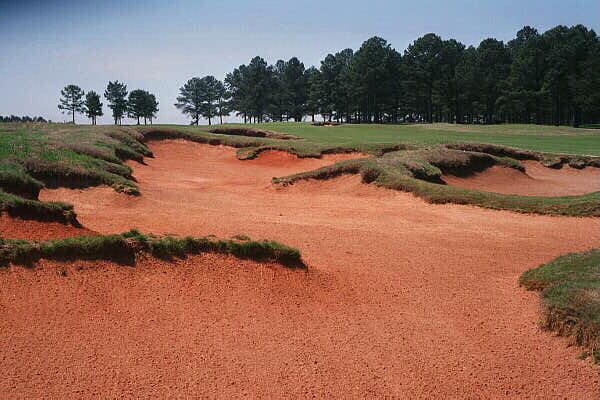
Jeff Bradley’s distinctive bunkering helps make Cuscowilla a standout among modern designs.
What makes a great ‘members’ course? How do you achieve both ‘playability’ and yet hold the low marker’s interest round after round throughout the years? Achieving this balance is the challenge, as each criterion can detract from the other. Too hard, and everyone throws their arms up in despair and heads home. Too easy, and people lose interest.
The Golf Club at Cuscowilla is a rare modern example of getting this balance just right.Borrowing from Alister MacKenzie’s famous quote re: the ideal golf hole, the ideal course ‘is surely one that affords the greatest pleasure to the greatest number, gives the fullest advantage for accurate play, stimulates players to improve their game, and never becomes monotonous.’ Such is the case at Cuscowilla as the course, which has atwo holes thatborder Lake Oconee in Georgia, is imminently playable and enjoyable for the 18-handicapper while equally intriguing to the low marker. The strict par of 70 contributes to the latter.
The fifth hole serves as a fine illustration on how Bill Coore and Ben Crenshaw accomplished this goal. From the back tees, the hole measures only 305 yards. A huge pit of a bunker dominates the hole as it comes within 24 yards of the front edge of the green and stretches back over 100 yards. The bunker is in direct line with the green from the tee and splits the generous right fairway from the smaller and tighter left side. The high marker has ample room down the right for his typical slice/fade shot pattern, from where he faces a short-iron to a green whose ‘only’ defense is its contours. The most precise of shots is needed to offer a realistic chance of a three; a good-but-not-great approach leaves the player with a four half the time; and a poor approach will likely result in five, but no worse.
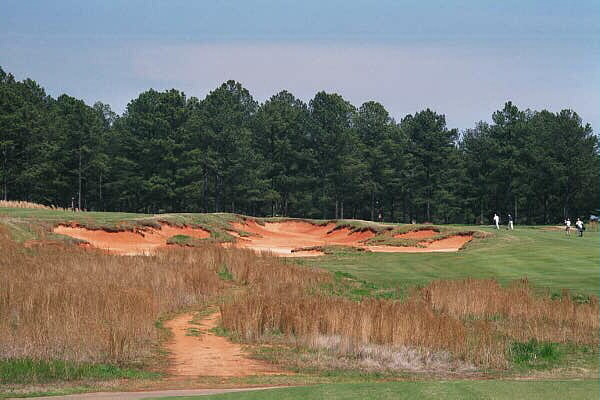
The view from the 5th tee, with a player left of the central hazard and a group of players right of it.
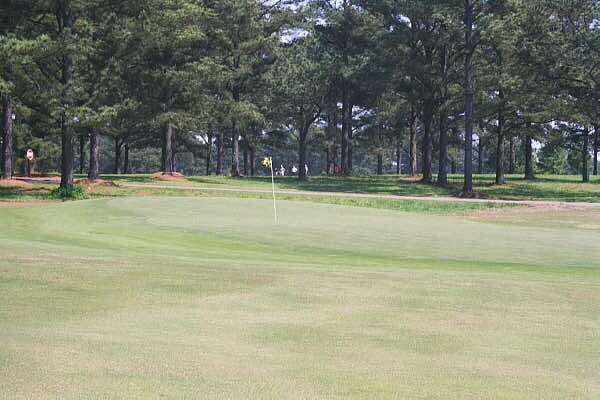
A successful 250 yard tee ball into the left fairway affords the golfer a perfect angle down the length of the green. The resulting pitch is still tricky though as it needs to contend with the swale in front of the green as well as the green’s left to right tilt.
For the low marker, however, the fifth presents an entirely different, but equally appealing, challenge. Even though it takes 250 uphill yards to carry the bunker, the player has difficulty not accepting the task. Plenty of fairway on both sides of the bunker encourages a good slash from the tee. The contours of the green and its slight left-to-right angle (which is accentuated the farther right, away from the bunker, one drives) will make him work hard for that desired three, no matter how good the drive.
As with both courses at Talking Stick, Coore and Crenshaw have produced first-rate bunkering from both an aesthetic/artistic perspective (courtesy ofJeff Bradley’s handwork) and a strategic one. The bunkers are deep, expansive where appropriate and without geometric edges. Importantly, the rugged edges to the bunkers don’t require additional maintenance – the edges are cut in the winter to one height and allowed to grow throughout the summer, requiring only the occasional trim and a machete cut of any bermuda runners. Uniquely, the sand is red/pink by design. After a few steady rains, the red Georgia clay and other sediments washed into the then white bunkers, creating this distinctive look that further differentiates the course.
Cuscowilla distinguishes itself also with the pacing and variety of the holes. The long holes (6, 8, 9, 13, 15 and 18) are spread out so that there is not necessarily one stretch of holes where the player can only brace himself and attempt to weather a four- or five-hole stretch. The shots that are asked of him are presented in a varied yet continuous flow.
The one shotters further highlight the variety found within the course. In one author’s round, the correct clubs for these holes were, in order, 4-iron, 3-wood, 9-iron and 7-iron. The 3rd has water on the left; the 11th on the right. The 8th green is angled left-to-right while the 16th is set at a right-to-left cant (although the green slopes left-to-right).
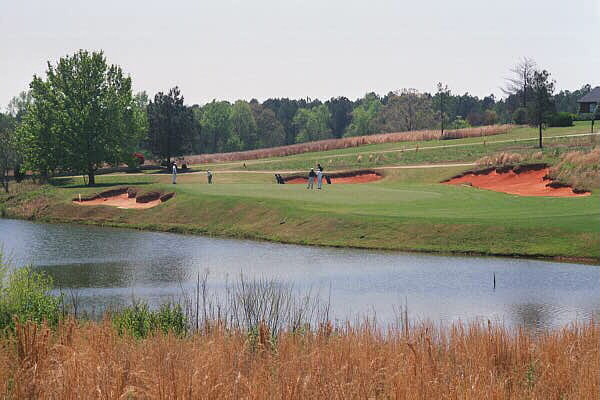
A slight pull on the 195 yard 3rd hole could spell trouble.
Special mention needs to be paid to Rusty Mercer and his staff for the presentation of the course. Considering how crucialthe area in front of the green is to holes 1, 2, 4, 5, 6, 8, 9, 10, 12, 13, and 15, much would be lost from this design without fast and firm playing conditions. Mercer obtains this firmness in part by top dressing the areas in front of the greens once a week andfocusing attention on these areas almost as if they were part of the green.
Holes to Note
1st hole, 380 yards; A striking opening hole that has no clear superior in inland golf, there is heaps of room to the right (where most players first shots go anyway), but the visually intimidating fairway bunkering on the left, the sole greenside bunker on the right and the green’s left-to-right angle create the strategy.
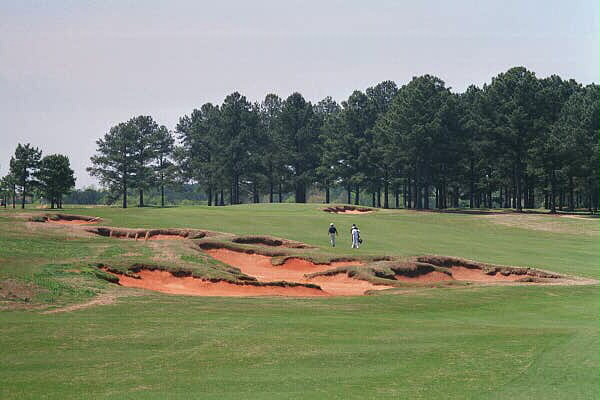
The ideal tee ball is to the left of the players walking up the 1st fairway, and that line also represents the longest carry over this impressive bunker complex.
2nd hole, 535 yards; As seen early in their careeron the back nine at Kapalua Plantation, Coore and Crenshaw have a keen understanding of the strategic merit of optional diagonal carries on their three shot holes. In the case here, the only way to have a clear pitch at a hole location on the back right shelf of the green is place the 2nd shot perfectly in front of the green, and that involves carrying the bunker pictured below.

The 50 yard diagonal bunker starts 130 yards from the green and golfers of all skill levels are free to choose which line is best for them.
The 50 yard diagonal bunker starts 130 yards from the green and golfers of all skill
levels are free to choose which line is best for them.
5th hole, 305 yards; While the preceding holewas anatural with a Cape drive across a lake and the 6th hole enjoys an expansive feel up on a plain, the property in between the twois just a gradual uphill slope. In short, it is the perfect place for an indifferenthole to exist. This is exactly the situationthat seperates good fromgreat architects and Coore rose to the occasion here by converting a wash area into a huge gaping bunker down what would normally havebeen the middle of the fairway. As noted above, the options that exist make this a strategic gem andit also allows Cuscowilla to enjoy a superb first six holes.
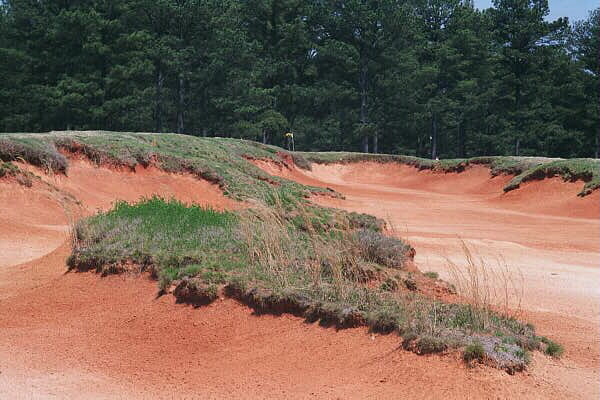
Best to avoid this central hazard at the uphill 5th!
6th hole, 465 yards; A long and basically flat hole across a plainthatwould fit in at Walton Heath (if there was any heath). Rather than just being a bystander, the left fairway bunker juts out near the line of play and clearly presents the job at hand: Play to the right and face a slightly longer approach or carry it (some 230 yards) for the easier approach. There are two bunkers some 20 yards short and right of the green that can certainly come into play for a long approach. Somewhat like the 6th at Woodhall Spa, these can affect where you land your second with a wooden club. The green was wisely left open in front.
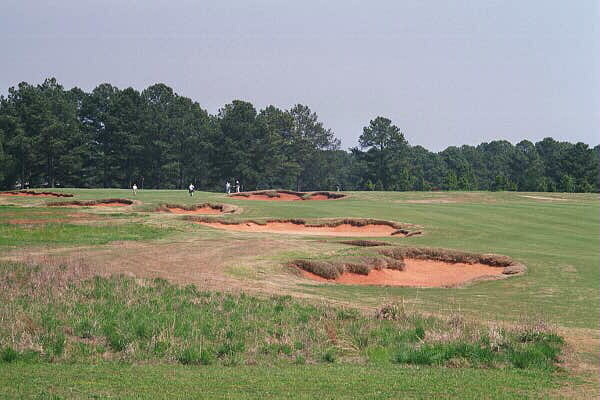
The closer the golfer can stay to the bunkers down the left of the fairway, the less he will have to contend with the large bunker right and short of the green.
8th hole, 235 yards; Unlike many modern designs, the ground game is alive and well at Cuscowilla. Played along a hill that leads down to the lake shore, the golfer is well advised to use the sloping terrain shy of the green. Consistent with the slope of the land, the green falls toward its back right anda tee ball that uses the slope and sends a ballslowlyon its waytoward the back hole locations is a sight that is beautiful to watch unfold.
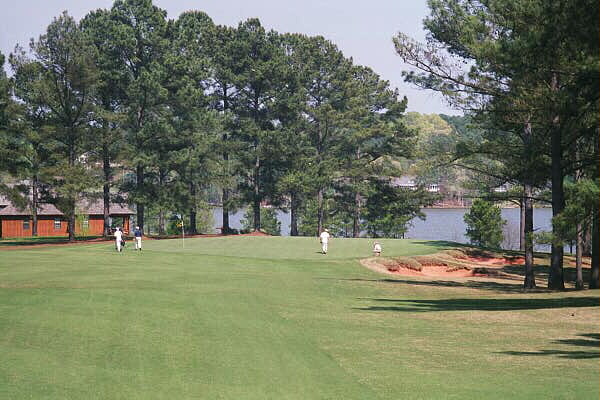
A ball hit at the left edge of the photograph and some fifteen yards shy of the green is still likely to kick right and onto the 8th green.
9th hole, 480 yards; After the tee shot out of a chute of trees hopefully finds the downslope to propel it another 30 yards, the player is faced with an approach reminiscent of the West Course at Royal Melbourne, thanks to the boldness of the green and bunkering.
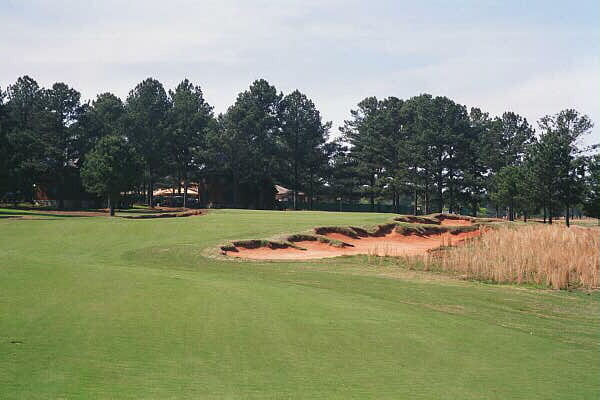
A long approach shot that carries this bunker and bounds onto the 9th green will thrill any golfer.
10th hole, 425 yards; Perhaps the finest ‘Cape’ hole built since the one at Mid-Ocean, Cuscowilla’s version is a mirror-image of Bermuda’s famous hole. After the dramatic drive off the elevated tee over the finger of Lake Oconee, the player has a mid-iron to the green whose main defense would appear to be the sole bunker to the right (which, fortunately, the architects did not turn into that now too-familiar ‘beach bunker’). However, the real trouble is to be found down the rather steep, closely-mown slope to the left. A player who is too conservative and misses the green left (away from the bunker and water) has little chance to save par as the green, particularly the left side, slopes to the right. As it turns out, he would have been better off to miss his shot in the bunker on the right.
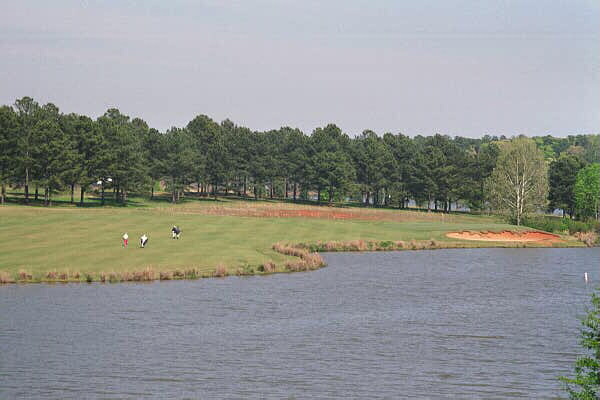
The intimidating view from the 10th tee.
11th hole, 135 yards; A charming but frustrating hole set along the lake, the 11th provides a nice change of pace after the rigors of the 6th, 8th and 9th holes and the drama of the 10th. As befits a hole of this length, the 11th features the most severe green on the course, with a false front that eats up the front left third of the green. The distance from the right edge of the green to the water is perfect – a ball that lands on the green but rolls off should stay dry while one that lands right of the green will find the water.
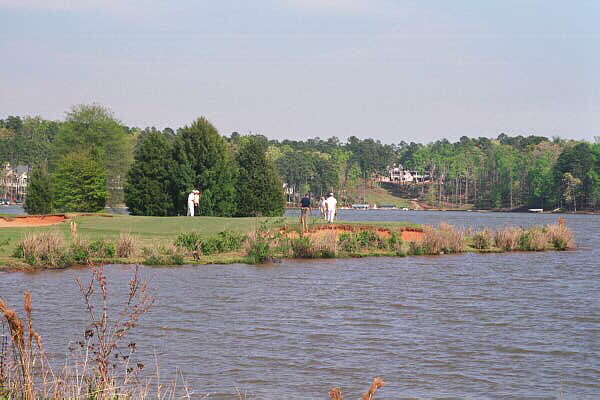
A dangerous short hole – the 11th at Cuscowilla.
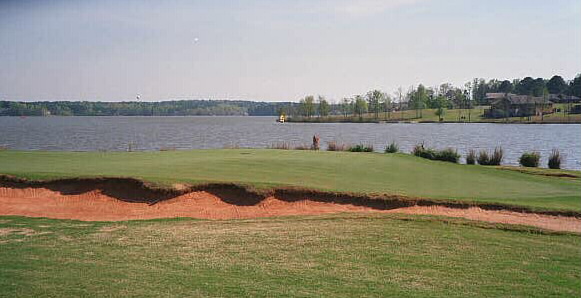
The false front is evident in this view from the left of the 11th green.
12th hole, 300 yards; This drivable hole compliments the 5th and 11th quite nicely. As the 12th is flat, driving the green is a more realistic play than at the 5th. However, what a precise shot is needed to find the green from the tee! The key is the bunker 15 yards short of the green in the right side of the fairway as the bold player must either carry it (quite a stout hit) or thread the gap between this bunker and the front-left greenside one. A draw or fade can do the trick, but the fade is the more dramatic shot as the player has to fire his tee shot over some pine trees that intrude from the left. The hole appropriately features the smallest green on the course complete with a good pitch to the front (one author witnessed a player 20 feet beyond a front hole location putt off the green).
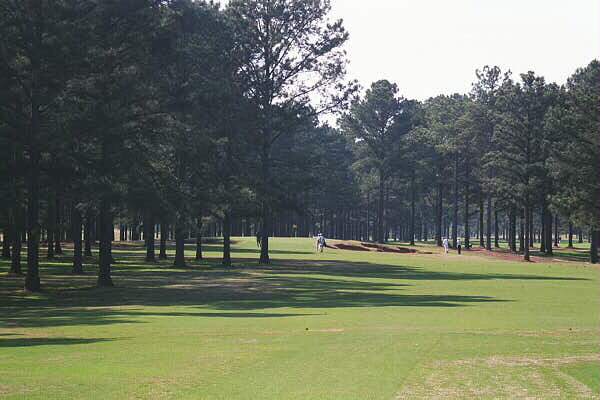
If the tall tree in the middle of the picture can be carried, the 12th green can be driven.
13th hole, 465 yards; While this bunkerless hole may not be as visually dynamic as many of the others, it is a perfect illustration of getting the most from the ground and of building a hole that is reflective of its environment. Anything left of center onthe green is likely to tumble down the closely mown bank and leave a testy recovery shot. The rigors of the 13thcompliments the drivable 12th.
15th hole, 445 yards; The 200 yard carryover wateris toa landing area that looks more pinched (by a bunker on the left and trees on the right) than it actually is as the trees hide the right part of the fairway. The approach is splendid, thanks to the authors’ favorite green on the course. The green would fit in at Chicago Golf Club, with its large, rectangular shape broken up by variety of undulations: a false front, a back-left knob and the right side that slopes off to the right.
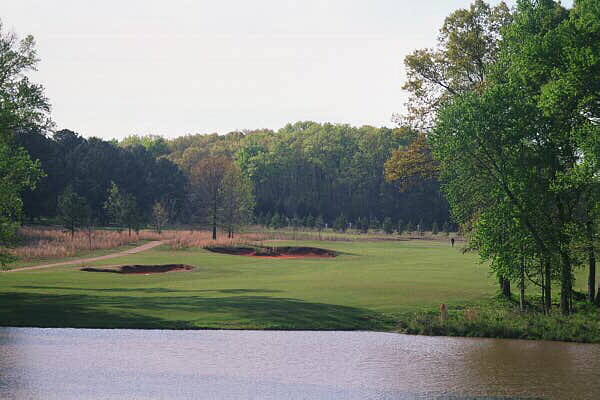
The view from the 15th tee.
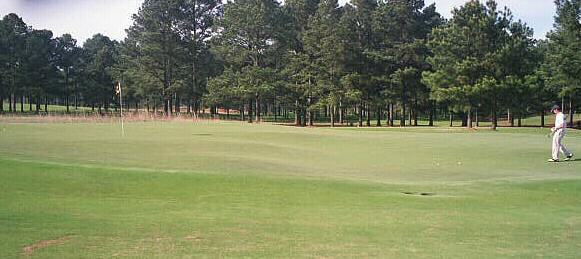
The 15th green is bunkerless with its impressive interior contours providing the challenge.
Cuscowilla is that rare course that plays well for both match and stroke play. An eight-handicapper can readily play four rounds on consecutive days without scoring worse than bogey, yet there are several holes (e.g., the 5th and 12th) that really come alive in a match and specific shots where the player can gain a great advantage over his opponent with a bold, well-placed drive (e.g., the 1st, 4th, 10th).
Why aren’t more modern courses built like Cuscowilla that strike that balance between reasonable demands on the player and interest? The answer lies in the approach that Coore and Crenshaw take with each project that they hand select. They do not accept projects where the owner is focused on seeing the course make a splashy appearance in the magazine rankings.Rather, they seek owners who sharea similar philosophy of building holes/courses that are reflective of theproperty and thatremain a joy to play for years to come. While almost everyarchitect makes such a claim, Cooreand Crenshaw actually deliver on the final product at Cuscowilla by a) taking their cue from nature (e.g. their use of the topography on holes 8 and 13 and their use of the lakeon 4 and 10) and b) their use of low profile features (e.g. the bunkering schemes at 1 and 5 and the interior green contours at 11 and 15).
Somewhat like New Jersey, the debate in Georgia is not about thefinest course in the state, but rather the second best. Cuscowilla wins that race, at least in the authors’ eyes. That is only fitting, as one of its architects knows something about golf in Georgia.
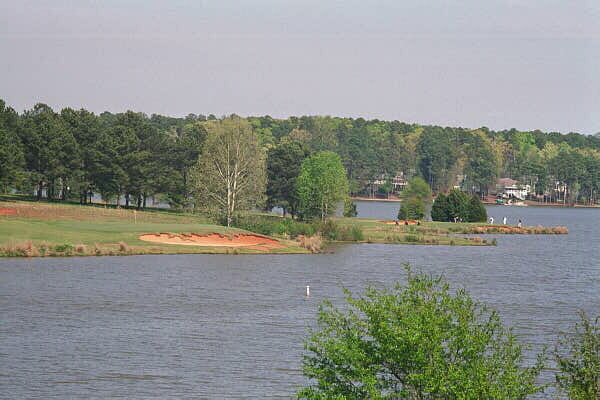
A member will never tire of this view from the elevated 10th tee with 10th green in the foreground and the 11th green on the point in the distance.
The End





![The Park, West Palm (Lit 9) [2023]](https://golfclubatlas.com/wp-content/uploads/2024/12/IMG_7092-2-scaled-500x383.jpg)


